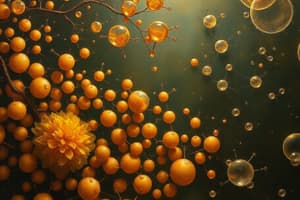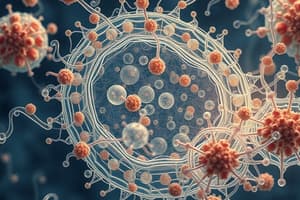Podcast
Questions and Answers
What causes intracellular protein accumulation?
What causes intracellular protein accumulation?
- Defects in cellular metabolism
- Increased degradation of proteins
- Excessive synthesis of proteins (correct)
- Reduced cellular absorption
Which of the following is an example of intracellular protein accumulation?
Which of the following is an example of intracellular protein accumulation?
- Hyperplastic cells in tissue
- Amyloid deposits in extracellular space
- Extravasated blood in tissues
- Reabsorption droplets in renal tubules (correct)
What is the appearance of abnormal protein deposits seen microscopically?
What is the appearance of abnormal protein deposits seen microscopically?
- Rounded and eosinophilic (correct)
- Reddish and sharp
- Granular and greenish
- Wavy and translucent
What is the characteristic of amyloid deposits when viewed under polarizing microscopy?
What is the characteristic of amyloid deposits when viewed under polarizing microscopy?
Which statement about hyaline change is true?
Which statement about hyaline change is true?
What type of protein accumulation is seen in α1-antitrypsin deficiency?
What type of protein accumulation is seen in α1-antitrypsin deficiency?
What is a common cause of extracellular hyaline change?
What is a common cause of extracellular hyaline change?
Which type of cells are primarily affected in the formation of Russell bodies?
Which type of cells are primarily affected in the formation of Russell bodies?
What type of intracellular accumulation can be caused by an excessive entry or defective metabolism of triglycerides?
What type of intracellular accumulation can be caused by an excessive entry or defective metabolism of triglycerides?
Which of the following is NOT a mechanism through which intracellular accumulations occur?
Which of the following is NOT a mechanism through which intracellular accumulations occur?
What condition is characterized by the accumulation of cholesterol in macrophages, often referred to as foam cells?
What condition is characterized by the accumulation of cholesterol in macrophages, often referred to as foam cells?
Which of the following is an example of abnormal exogenous substance accumulation?
Which of the following is an example of abnormal exogenous substance accumulation?
Alpha-1 antitrypsin disease primarily leads to the accumulation of which type of substances?
Alpha-1 antitrypsin disease primarily leads to the accumulation of which type of substances?
What is the primary contributing factor to alcohol-induced fatty liver?
What is the primary contributing factor to alcohol-induced fatty liver?
Which intracellular accumulation is primarily associated with lysosomal storage disease?
Which intracellular accumulation is primarily associated with lysosomal storage disease?
What type of intracellular accumulation might lead to a pale yellow appearance of the parenchyma in the liver?
What type of intracellular accumulation might lead to a pale yellow appearance of the parenchyma in the liver?
What is the primary role of glycogen in cells?
What is the primary role of glycogen in cells?
What type of calcification occurs in non-viable tissues with normal serum calcium levels?
What type of calcification occurs in non-viable tissues with normal serum calcium levels?
Which pigment is known to be a yellow-brown intracytoplasmic granule?
Which pigment is known to be a yellow-brown intracytoplasmic granule?
What substance is a common exogenous pigment found in the lungs due to pollution?
What substance is a common exogenous pigment found in the lungs due to pollution?
Which of the following diseases is associated with defects in lysosomal enzymes that break down glycogen?
Which of the following diseases is associated with defects in lysosomal enzymes that break down glycogen?
What is primarily deposited in pathologic calcification in tissues?
What is primarily deposited in pathologic calcification in tissues?
What type of pigments are carbon and coal dust considered?
What type of pigments are carbon and coal dust considered?
What morphological characteristics does a compound naevus exhibit?
What morphological characteristics does a compound naevus exhibit?
What is a common cause of bone destruction due to primary tumors?
What is a common cause of bone destruction due to primary tumors?
Which condition is associated with accelerated bone turnover leading to bone destruction?
Which condition is associated with accelerated bone turnover leading to bone destruction?
What is the primary cause of metastatic calcification?
What is the primary cause of metastatic calcification?
Which pigment is typically indigestible and can be deposited in cells due to overload?
Which pigment is typically indigestible and can be deposited in cells due to overload?
What type of calcification occurs at sites of cell injury and necrosis?
What type of calcification occurs at sites of cell injury and necrosis?
Which of the following is NOT an example of dystrophic calcification?
Which of the following is NOT an example of dystrophic calcification?
What substance is primarily involved in the initiation phase of dystrophic calcification?
What substance is primarily involved in the initiation phase of dystrophic calcification?
Where does intracellular calcification primarily occur during the initiation phase?
Where does intracellular calcification primarily occur during the initiation phase?
Which factor influences the propagation phase of dystrophic calcification?
Which factor influences the propagation phase of dystrophic calcification?
What is a common clinical sequel of metastatic calcification?
What is a common clinical sequel of metastatic calcification?
In dystrophic calcification, what do membrane-bound phosphatases generate?
In dystrophic calcification, what do membrane-bound phosphatases generate?
Which of the following conditions is associated with metastatic calcification?
Which of the following conditions is associated with metastatic calcification?
What characterizes the deposits formed in metastatic calcification?
What characterizes the deposits formed in metastatic calcification?
Flashcards are hidden until you start studying
Study Notes
Introduction to Intracellular Accumulations
- Intracellular accumulation indicates metabolic derangements in cells, potentially leading to cellular injury.
- Substances may be found in the cytoplasm, organelles, or nucleus.
- Types of accumulated substances include:
- Normal endogenous substances produced at normal or increased rates but not adequately removed (e.g., fat in liver cells).
- Abnormal endogenous substances produced by mutated genes with defective transport or inadequate degradation (e.g., α1-antitrypsin disease).
- Normal substances accumulating due to metabolic defects (e.g., lysosomal storage diseases).
- Abnormal exogenous substances that cannot be degraded (e.g., macrophages with environmental carbon).
Common Intracellular Accumulations
- Major forms include lipids, proteins, hyaline changes, glycogen, and pigments.
Lipid Accumulation
- Lipids accumulate as triglycerides, cholesterol, and phospholipids, manifesting as steatosis (fatty changes).
- Fatty liver is characterized by excessive triglyceride accumulation in hepatic cells due to factors like alcohol abuse, diabetes mellitus, and obesity.
- Cholesterol accumulation leads to intracellular cytoplasmic vacuoles and is seen in conditions like atherosclerosis and Niemann-Pick disease type C.
Protein Accumulation
- Protein accumulation results from excessive synthesis or defects in cellular transport, seen microscopically as eosinophilic cytoplasmic droplets.
- Common instances include:
- Reabsorption droplets in renal tubules in chronic proteinuria.
- Russell bodies in plasma cells due to excess immunoglobulin production.
- Defective transport examples include α1-antitrypsin deficiency with protein buildup in hepatocyte endoplasmic reticulum.
- Abnormally folded proteins can accumulate and lead to pathologies like amyloidosis.
Hyaline Change
- Refers to a glassy, homogenous appearance in histologic sections.
- Intracellular examples include protein droplets in renal epithelium and viral inclusions.
- Extracellular examples occur in arterioles affected by chronic hypertension.
Glycogen Accumulation
- Glycogen serves as an energy reserve but excessive deposits occur in glycogen storage diseases and diabetes mellitus, appearing as clear vacuoles.
Pigment Accumulation
- Pigments can be exogenous (e.g., carbon, tattoo ink) or endogenous (e.g., lipofuscin, melanin).
- Lipofuscin is a yellow-brown granule resulting from lipid peroxidation; hemosiderin is an iron overload pigment.
Pathologic Calcification
- Involves abnormal calcium salt deposits in non-osseous tissues, often linked with other mineral deposits.
- Two main types:
- Dystrophic Calcification: Develops in damaged or necrotic tissues with normal serum calcium. Examples include atherosclerosis and psammoma bodies.
- Metastatic Calcification: Occurs due to systemic hypercalcemia; commonly results from conditions like hyperparathyroidism and renal failure.
Mechanism of Dystrophic Calcification
- Initiation involves nucleation on membrane vesicles from dead cells, focusing calcium due to phospholipid content.
- Propagation depends on calcium and phosphate concentrations, presence of inhibitors, and structural components of the extracellular matrix.
Summary of Findings
- Intracellular and tissue accumulation can lead to clinical pathologies.
- Dystrophic calcification is typically linked to tissue injury, while metastatic calcification arises from elevated serum calcium levels, impacting normal tissues.
Studying That Suits You
Use AI to generate personalized quizzes and flashcards to suit your learning preferences.




